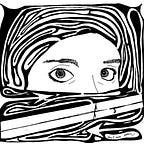The anthropology of the myco-revolution
When I tell people I’m an anthropologist researching a community in the SF Bay Area, they’re sometimes puzzled. “Aren’t you supposed to be studying an obscure tribe in the Amazon?,” they ask me. At that point, I explain that since the 1960s anthropologists now study a broad variety of people. My research focuses on the culture and society I know best, North America — specifically the ecologically inspired cultures that are heir to the counterculture of the 1960s.
What I find fascinating about these cultural streams is both their diversity and the broad effects they’ve had on mainstream American culture, both subverting mainstream culture through political activism, and engaging with traditional business models and scientific institutions that seek to transform those structures from the inside out. Historians Andrew Kirk and Sam Binkley have shown how ecological movements have been especially influential in this second sense. They’ve reshaped consumer practices and given rise to entirely new industries.
For example, take the food movement. The revival of organic produce grew out of the back-to-the-land movement of the early 1970s. That led to the revival of farmers markets and then the rise of “natural food” stores. And that led to countless new brands catering to this emergent demographic and their new tastes and aesthetics. Eventually, we saw the rise of companies like Whole Foods that helped make a once-niche market into a $35 billion industry in the US alone. (Organic food now accounts for %5 of the total food sales in the US.) California in particular has been transformed by these shifts.
In my research, I wanted to understand how ecological cultures rooted in this history relate to science and technology. I’ve always been particularly fascinated by amateur ecological technologies like permaculture, aqua-ponics, and natural building (e.g., cob ovens). These practices involve scientific know-how but don’t require expert learning, and while they necessitate a reliance on modern scientific knowledge, they’re often framed as a revival or a return to premodern ecologies. This paradox presented a nice puzzle for me to play with.
When I began my dissertation research on “do-it-yourself” (DIY) mycologists, I knew next to nothing about mushrooms. I faced a steep learning curve. As I moved through this distinctive scientific subculture, I was constantly surprisedly by how strange and captivating fungi actually are.
Somewhere between mineral, animal, and vegetable (it has it’s own taxonomic kingdom), fungi are unlike other living things — like plants and other animals — that we commonly invite into our daily lives. It is coaxed and cultivated in ways both familiar and alien, affording unusual and unique capacities and possibilities. What’s more, mycology is a relatively new scientific discipline. The elementary dynamics of fungal biology were unknown until the improved compound microscopes of the late 1700s. There is still so much that we don’t know and so much that we’re learning all the time.
In trying to make sense of my research, I became more aligned with what’s called “multispecies” anthropology. This approach expands the focus of anthropology to include the nonhuman forces that shape our world. Such forces can be good — like the microbes that ferment our food and alcohol — or bad — like the pathogens that make us sick or the “pests” that eat our crops before we can. This approach recognizes a basic ecological principle: we are always in relation to the living world around us. If we’re going to survive, we must calibrate our own lives with these other lives. And if we’re going to thrive, we must learn to forge alliances with these other lives. (Such an approach is illustrated beautifully by anthropologist Anna Tsing’s most recent book, The Mushroom at the End of the World.) Myco-technologies are one example of how we might forge such an alliance. I see these practitioners as being driven by a familiar mix of ideological commitment and eco-pragmatism, constantly negotiating with questions of scale, production, and human needs.
It was in this vein that I came across MycoWorks. Introduced through a friend, I discovered their myco-materials at the annual San Francisco Fungus Fair. As I finished up my field work, an opportunity to join the MycoWorks team arose and I jumped at it. As an anthropologist, I see myself as a translator between the distinctive scientific culture of DIY mycology — with all of its knowledge and potential — and the immense audience that can benefit from these biotechnological advances.
I have no doubt that the market for ecologically sustainable materials and products will continue to grow as environmental damage becomes more visible and pressing. Consumers and investors will demand technologies that are ecologically benign (or even better — beneficial) as well as economically sustainable and well-designed. The potential in applied mycology as a regenerative technology is clear. How can we further develop this new collaboration between humans and kingdom fungi? As MycoWorks moves to the next level as a company, we will begin to open up the potential in this new relationship.
